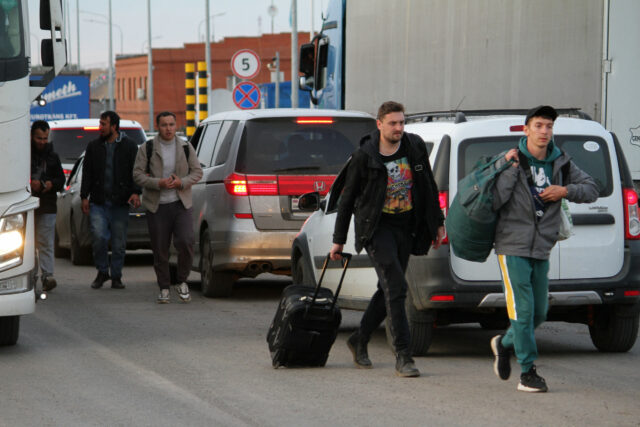
Influx of Russians Fleeing Mobilization Increasingly Alienating Central Asians
Publication: Eurasia Daily Monitor Volume: 19 Issue: 149
By:

More than half of the estimated 700,000 Russians who have fled since Russian President Vladimir Putin declared partial mobilization on September 21 have mainly gone to four countries in Central Asia—Kazakhstan, Uzbekistan, Kyrgyzstan and Tajikistan—among the relatively few places Russians can still enter freely without visas (Forbes.ru, October 4). Most of these arrivals plan to move on to other countries—and indeed, many already have—or ultimately return to Russia after Putin leaves the scene. But, at the moment, both those in transit and those who stay for a longer period are creating problems for national citizens and governments, exacerbating tensions between the titular nations and ethnic Russians in each state and between the governments of these countries and the Russian Federation.
The influx of Russians into the Republic of Georgia (53,000) and European Union members (66,000) has attracted more attention with regard to both the problems they have created for the host nations and the anger of the populations and actions of officials in both places to restrict such immigration (Fontanka.ru, September 27; T.me/Bbcrussian, September 27; Novaya gazeta, October 5). But the numbers flowing into Central Asia has been far larger—over 200,000 into Kazakhstan, just under that figure into Uzbekistan and much smaller flows into Kyrgyzstan and Tajikistan. (Turkmenistan, as in almost all cases, remains largely closed to this flow.) Many of these Russians are moving on: The Kazakhstani government says that almost 75 percent of those who have entered since September 21 have since done so (Kommersant, October 4). Even so, large numbers remain and are creating serious problems.
Many Central Asians initially welcomed the influx of Russians opposed to the war in Ukraine, seeing them as allies within Russia against any plans by Putin to attack or absorb their countries in the future. Yet, from the outset, some officials in many of these countries appeared to fear that the more independent-minded Russians who have arrived could cause problems for their authoritarian regimes in the future (Forbes.ru, October 4). And some in the population and government welcomed those with money to spend and with skills the Central Asian economies need. But these positive feelings disappeared quickly, with many Central Asians upset by the sharp increase in inflation brought by the Russians’ arrival, the loss of jobs in some cases for locals and the new arrivals’ attitudes toward local laws and customs (Cabar.asia, October 6). All this has led to demands that either Russians be blocked from entering the region altogether or that those who do come be confined to refugee camps so they cannot harm the rest of the population with their money and attitudes (Abai.kz, September 30; Caravan.kz, October 3; Forbes.ru, October 4).
Such public feelings concern Moscow, which views them as a manifestation of rampant Russophobia (QMonitor, October 6; Stan Radar, October 7). But the Russian authorities undoubtedly are more concerned about how the Kremlin’s actions in Ukraine and the resulting influx of Russians into Central Asia are affecting government attitudes in the region, all of which face enormous pressure to follow Russia’s line but have increasing reason to oppose what Moscow is doing in Ukraine. The Central Asian governments are anything but enthusiastic backers of Putin’s war against Ukraine (K-politika.ru, October 3). But they are, if anything, even more worried by the impact of Russian efforts to force them to return the recent Russian arrivals, who for example. in Tajikistan, have been harassed by Russian forces and who elsewhere have been checked by local police at the Kremlin’s insistence, actions that undermine these countries’ independence (Eurasia Today, September 29; Stan Radar, October 7).
The arrival of large numbers of Russians has thus put the governments of Central Asia in a difficult position. They welcome the influx of Russian money, which has helped their economies rebound faster than most expected, and are no doubt happy to show the West that they are opposed to Putin’s war in Ukraine. But they are also concerned about the growth of anti-Russian attitudes that the war and the arrival of ethnic Russians are provoking, sentiments that could deepen ethnic divides within their own countries and produce instability. Indeed, this cold reception has already alarmed Moscow and led the Kremlin to be even more demanding in its dealings with these regimes (QMonitor, October 6; Stan Radar, October 7). The Central Asian governments are thus likely to take steps that will quietly encourage the recent Russian arrivals to move on to other countries rather than remain—in hopes that this problem will go away on its own. But whether that will be enough for either the indigenous populations or for Moscow remains an open question.
Local populations, accustomed over recent decades to the outflow of ethnic Russians, are unlikely to be happy if the number of ethnic Russians among them increases as it did in Soviet times. And they could become radicalized as a result (Mk.ru, September 3, 2021). As such, the Kremlin is certain to be alarmed and might even take more aggressive action against the governments in the region—especially since many in Moscow are already talking about the possibility that Kazakhstan is on its way to becoming “a second Ukraine,” with all the ensuing consequences (Svpressa.ru, September 3, 2021). Both these risks make the fate of the recent Russian arrivals in Central Asia far more critical to regional security than a more superficial glance might suggest.



